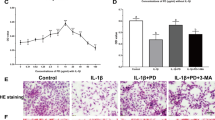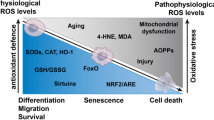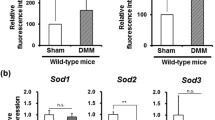Abstract
Upregulation of matrix metalloproteinases (MMPs) is a hallmark of osteoarthritis progression; along with the role reactive oxygen species (ROS) may play in this process. Moreover, mitochondrial DNA damage and dysfunction are also present in osteoarthritic chondrocytes. However, there are no studies published investigating the direct relationship between mitochondrial ROS, mitochondrial DNA damage, and MMP expression. Therefore, the purpose of the present study was to evaluate whether mitochondrial DNA damage and mitochondrial-originated oxidative stress modulates matrix destruction through the upregulation of MMP protein levels. MitoSox red was utilized to observe mitochondrial ROS production while a Quantitative Southern blot technique was conducted to analyze mitochondrial DNA damage. Additionally, Western blot analysis was used to determine MMP protein levels. The results of the present study show that menadione augmented mitochondrial-generated ROS and increased mitochondrial DNA damage. This increase in mitochondrial-generated ROS led to an increase in MMP levels. When a mitochondrial ROS scavenger was added, there was a subsequent reduction in MMP levels. These studies reveal that mitochondrial integrity is essential for maintaining the cartilage matrix by altering MMP levels. This provides new and important insights into the role of mitochondria in chondrocyte function and its potential importance in therapeutic approaches.





Similar content being viewed by others
References
Pagano G, Talamanca AA, Castello G, Cordero MD, d’Ischia M, Gadaleta MN, Pallardo FV, Petrovic S, Tiano L, Zatterale A (2014) Oxidative stress and mitochondrial dysfunction across broad-ranging pathologies: toward mitochondria-targeted clinical strategies. Oxid Med Cell Longev 1–27 doi.org/10.1155/2014/541230
Ruiz-Romero C, Calamia V, Mateos J, Carreira V, Martinez-Gomariz M, Fernandez M, Blanco F (2009) Mitochondrial dysregulation of osteoarthritic human articular chondrocytes analyzed by proteomics. Mol Cell Proteomics 8(1):172–189
Pelletier JP, Jovanovic DV, Lascau-Coman V, Fernandes JC, Manning PT, Connor JR et al (2000) Selective inhibition of inducible nitric oxide synthase reduces progression of experimental osteoarthritis in vivo: possible link with the reduction in chondrocyte apoptosis and caspase 3 level. Arthritis Rheum 43:1290–1299
Grishko V, Renee H, Wilson GL, Pearsall AW (2009) Diminished mtDNA integrity and repair capacity in OA chondrocytes. Osteoarthritis Cartilage 17:107–113
Johnson K, Jung AS, Andreyev A, Murphy A, Dykens J, Terkeltaub R (2000) Mitochondrial oxidative phosphorylation is a downstream regulator of nitric oxide effects on chondrocyte matrix synthesis and mineralization. Arthritis Rheum 43(7):1560–1570
Loeser RF, Carlson CS, Del Carlo M, Cole A (2002) Detection of nitrotyrosine in aging and osteoarthritic cartilage: correlation of oxidative damage with the presence of interleukin-1 beta and with chondrocyte resistance to insulin-like growth factor 1. Arthritis Rheum 46:2349–2357
Carlo MD, Schwartz D, Erickson EA, Loeser RF (2007) Endogenous production of reactive oxygen species is required for stimulation of human articular chondrocyte matrix metalloproteinase production by fibronectin fragments. Free Radic Biol Med 42:1350–1358
Nelson KK, Melendez JA (2004) Mitochondrial Redox Control of Matrix Metalloproteinases. Free Radic Biol Med 37:768–784
Lewis EJ, Bishop J, Bottomley KM, Bradshaw D, Brewster M, Broadhurst MJ, Brown PA, Budd JM, Elliott L, Greenham AK, Johnson WH, Nixon JS, Rose F, Sutton B, Wilson K (1997) Ro 32-3555, an orally active collagenase inhibitor, prevents cartilage breakdown in vitro and in vivo. Br J Pharmacol 121:540–546
Turrens JF (2003) Mitochondrial formation of reactive oxygen species. J Physiol 552:335–344
Chance B, Williams GR (1995) Respiratory enzymes in oxidative phophorylation. I. Kinetics of oxygen utilization. J Biol Chem 217:383–393
Grill L, Nohl H (2001) The ubiquinol/bc1 redox couple regulates mitochondrial oxygen radical formation. Arch Biochem Biophys 388:34–38
Lee RB, Urban JP (1997) Evidence for a negative Pasteur effect in articular cartilage. Biochem J 321:95–102
Maneiro E, Martin MA, de Andres MC, Lopez-Armada MJ, Fernandez-Sueiro JL, del Hoyo P et al (2003) Mitochondrial respiratory activity is altered in OA human articular chondrocytes. Arthritis Rheum 48:700–708
Roach HI (2008) The complex pathology of osteoarthritis: even mitochondria are involved. Arthritis Rheum 58(8):2217–2218 (32)
Mukhopadhyay P, Rajesh M, Yoshihiro K, Hasko G, Pacher P (2007) Simple quantitative detection of mitochondrial superoxide production in live cell. Biochem Biophys Res Commun 358(1):203–208
Grishko V, Xu M, Wilson G, Pearsall A (2010) Apoptosis and mitochondrial dysfunction in human chondrocytes following exposure to lidocaine, bupivacaine, and ropivacaine. J Bone Joint Surg Am 92:609–618
Schon EA, DiMauro S, Hirano M (2012) Human mitochondrial DNA: roles of inherited and somatic mutations. Nat Rev Genet 13(12):878–890
Suzuki S, Hinokio Y, Komatu K, Ohtomo M, Onoda M, Hirai S, Hirai M et al (1999) Oxidative damage to mitochondrial DNA and its relationship to diabetic complications. Diabetes Res Clin Pract 45(2–3):161–168
Lim PS, Cheng YM, Wei YH (2000) Large-scale mitochondrial DNA deletions in skeletal muscle of patients with end stage renal disease. Free Radic Biol Med 29:454–463
Linnane AW, Marzuki S, Wzawa T, Tanaka M (1989) Mitochondrial DNA mutations as an important contributor to aging and degenerative disease. Lancet i:642–645
Sohal RS, Agarwal A, Agarwal S, Orr WC (1995) Simultaneous overexpression of copper and zinc-containing superoxide dismutase and catalase retards age-related oxidative damage and increases metabolic potential in Drosophila melanogaster. J Biol Chem 270:15671–15674
Sohal RS, Agarwal S, Bubey A, Orr WC (1993) Protein oxidative damage is associated with life expectancy of houseflies. Proc Natl Acad Sci USA 90:7255–7259
Rego-Perez I, Fernandez-Moreno M, Fernandez-Lopez C, Arenas J, Blanco FJ (2008) Mitochondrial DNA haplogroups: role in the prevalence and severity of knee osteoarthritis. Arthritis Rheum 58(8):2387–2396
Kim J, Xu M, Ho R, Mates A, Wilson GL, Pearsall AW, Grishko V (2010) Mitochondrial DNA damage is involved in apoptosis caused by pro-inflammatory cytokines in human OA. Osteoarthritis Cartilage 18:424–432
Lopez-Armada MJ, Carames B, Martin MA, Cillero-Pastor B, Lires-Dean M, Fuentes-Boquete I, Arenas J, Blanco FJ (2006) Mitochondrial activity is modulated by TNF alpha and IL-1beta in normal human chondrocyte cell. Osteoarthritis Cartilage 14(10):1011–1022
Wolff KJ, Ramakrishnan PS, Brouillette MJ, Journot BJ, McKinley TO, Buckwalter JA, Martin JA (2013) Mechanical stress and ATP synthesis are coupled by mitochondrial oxidants in articular cartilage. J Orthop Res 31(2):191–196
Brenneisen P, Wenk J, Klotz LO, Wlaschek M, Briviba K, Krieg T, Sies H, Scharffetter-Kochanek K (1998) Central role of ferrous/ferric iron in the ultraviolet B irradiation-mediated signaling pathway leading to increased interstitial collagenase (matrix-degrading metalloprotease (MMP)-1) and stromelysin-1 (MMP-3) mRNA levels in cultured human dermal fibroblasts. J Biol Chem 273(9):5279–5287
Vaamonde-García C, Riveiro-Naveira RR, Valcárcel-Ares MN (2012) Mitochondrial dysfunction increases inflammatory responsiveness to cytokines in normal human chondrocytes. Arthritis Rheum 64:2927–2936
Stowe DF, Camara AK (2009) Mitochondrial reactive oxygen species production in excitable cells: modulators of mitochondrial and cell function. Antioxid Redox Signal 11:1373–1414
Vincent F, Brun H, Clain E, Ronot X, Adolphe M (1989) Effects of oxygen free radicals on proliferation kinetics of cultured rabbit articular chondrocytes. J Cell Physiol 141:262–266
Monboisse JC, Braquet P, Borel JP (1983) Non enxymatic degradation of acid soluble collagen by superoxide anion: protective effect of flavonoids. Biochem Pharmacol 32:53–58
Cillero-Pastor B, Rego-Perez I, Oreiro N, Fernandez-Lopez C, Blanco Francisco (2013) Mitochondrial respiratory chain dysfunction modulates metalloproteases -1, -3 and -13 in human normal chondrocytes in culture. BMC Musculoskelet Disord 14:235
Henrotin E, Bruckner P, Pujol JP (2003) The role of reactive oxygen species in homeostasis and degradation of cartilage. Osteoarthritis Cartilage 11:747–755
Author information
Authors and Affiliations
Corresponding author
Rights and permissions
About this article
Cite this article
Reed, K.N., Wilson, G., Pearsall, A. et al. The role of mitochondrial reactive oxygen species in cartilage matrix destruction. Mol Cell Biochem 397, 195–201 (2014). https://doi.org/10.1007/s11010-014-2187-z
Received:
Accepted:
Published:
Issue Date:
DOI: https://doi.org/10.1007/s11010-014-2187-z




